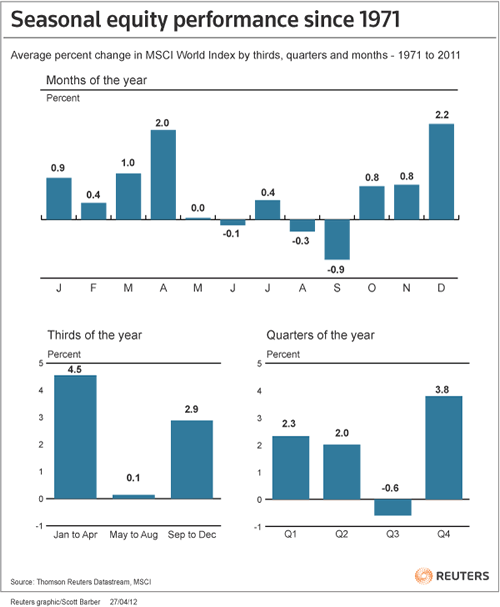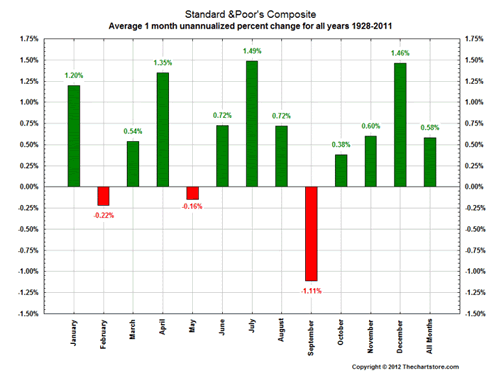“Sell in May and go away” is a rhyming market-timing slogan that may never… go away. Here’s a graphic that seems to support the idea that stocks have historically performed much worse between May and October than the rest of the year. Credit to Reuters/Scott Barber via Abnormal Returns. Data set is the MSCI World Index from 1971-2011.

Meanwhile, The Big Picture shares a bunch of graphs from TheChartStore that don’t make it look so clear-cut. Looking at this one, why shouldn’t just bail out every September? Data set is the S&P 500 from 1928-2011.

Larry Swedroe tests the theory out using 30-day Treasury bonds as the alternative investment in this CBS Moneywatch article:
He looked at returns through 2007 from six start dates since 1950. “Sell in May” beat “buy and hold” if you started investing in 1960, 1970 and 2000, but not if you started in 1950, 1980 or 1990. “It’s pure randomness,” Swedroe says. “How would you ever know when to start?”
Throw in the tax implications of all that buying and selling, and I agree. Do you really want to base your investing strategy on a data-mining result that has no logical explanation behind it? Sounds too much like driving a car using only your rearview mirror.
However, Tadas Viskanta of Abnormal Returns has what I think is a reasonable compromise – what if you just decided to rebalance your portfolio at the very end of April and the very end of October? You should rebalance your portfolio regularly anyway, so why not do it twice a year, six months apart. If your target asset allocation is 70% stocks/30% bonds and now you’re at 80/20 due to the recent run-up, why not go back to 70/30. If things end up at 60/40 in November, then again, go back to 70/30.
You could call it “Remember to Rebalance in May and November”. It even rhymes! If “sell in may” really works, you’ll get some benefit from this mean reversion wackiness. If it’s just noise, you portfolio shouldn’t theoretically be hurt any more than picking other months.
 The Best Credit Card Bonus Offers – 2025
The Best Credit Card Bonus Offers – 2025 Big List of Free Stocks from Brokerage Apps
Big List of Free Stocks from Brokerage Apps Best Interest Rates on Cash - 2025
Best Interest Rates on Cash - 2025 Free Credit Scores x 3 + Free Credit Monitoring
Free Credit Scores x 3 + Free Credit Monitoring Best No Fee 0% APR Balance Transfer Offers
Best No Fee 0% APR Balance Transfer Offers Little-Known Cellular Data Plans That Can Save Big Money
Little-Known Cellular Data Plans That Can Save Big Money How To Haggle Your Cable or Direct TV Bill
How To Haggle Your Cable or Direct TV Bill Big List of Free Consumer Data Reports (Credit, Rent, Work)
Big List of Free Consumer Data Reports (Credit, Rent, Work)
Sounds advice perhaps, but that doesn’t rhyme.
I’ve heard a lot about 70/30 or 80/20 for stocks and bonds. I only own stocks and was wondering how to start investing in bonds. Where do I start and what am I looking for?
There is some good research out there supporting growth in summer months during an election year. I think the sell off for May occurred in April of 2012. I’m not releasing any of my positions this summer.
Is there any information on the re-balancing schedule of Vanguard’s Target Retirement funds? I’ve always been curious.
@David:
Rebalance, Remember, May & November.
Whatcha think?
Remember, remember to rebalance in November (and also in May)?
@Jaroos Some use (100-age)/100 =stock portion, the rest bonds, others substitute expected life in place of 100 (e.g. 80 or 90). The idea is to reduce risk over time to very little as you near expiration. 80/20 makes sense when you are young, it is aggressive when you near retirement. Never too late to look at bonds, especially the I Series.
I also have a target date fund with vanguard.
I have been doing dollar cost averaging on a roth and noticed that from 2007 to jan2012, i barely broke even.
Im planning to do a lump sum on the next market correction.
I’ve been kicking myself for just leaving it on auto-pilot.
Haha I love seeing things like this. Technical analysts make me laugh.
cool. I am ready to sell some of my bond ETF and buy some stock ETF.
Thank you For this post. I feel like a lot of people are not sure when the exact time is to buy low or sell high on stocks. Your charts helped out tremendously. Maybe this will help the economy in the future if everyone is more educated on Highs and Lows.